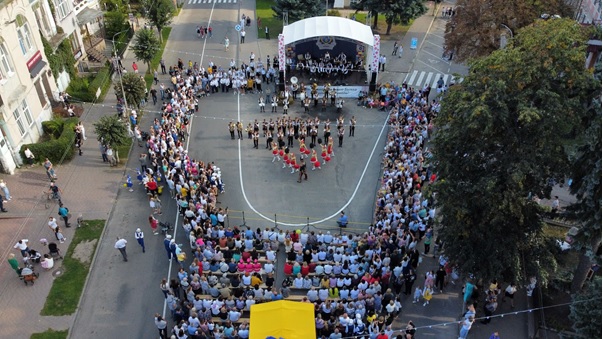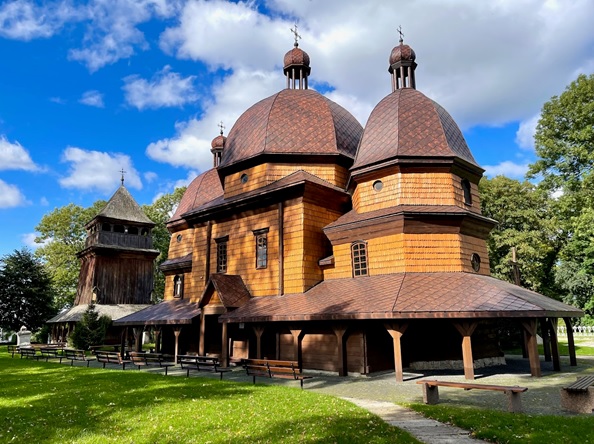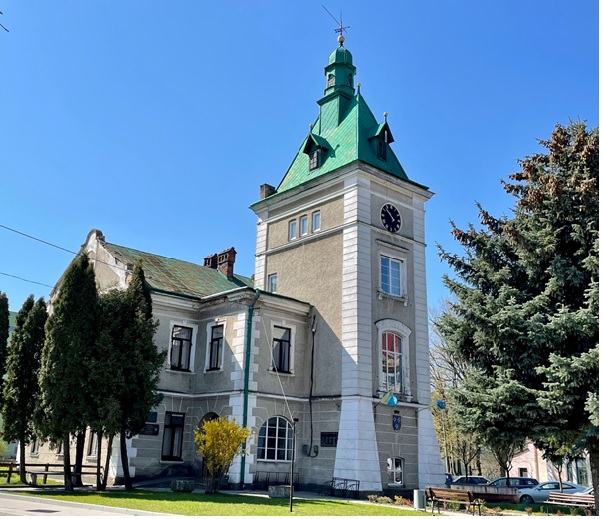This website uses cookies so that we can provide you with the best user experience possible. Cookie information is stored in your browser and performs functions such as recognising you when you return to our website and helping our team to understand which sections of the website you find most interesting and useful.
Kamianka-Buzka Territorial Community

The Kamianka-Buzka Territorial Community is located in the Lviv district of the Lviv region. The distance to Lviv is 44 km, and to the EU border by the nearest road is 69.2 km.
Population of the community is 21,354 people (10,094 men and 11,260 women)
urban residents: 10,257
rural residents: 11,097
including 409 internally displaced persons.
Territorial community area: 344.4 km2
There are 29 population centres in the community, with the administrative centre in Kamianka-Buzka.
History
Until August 15, 1944 Kamianka-Buzka had been called Kamianka-Strumilivska or Strumilova. The first written mention of Kamianka dates back to 1406 and 1411. At that time it was called Dymoshyn.
From the middle of the 15th century it was called Kamianka-Strumilova after its owner, Lviv sub-commissary Jerzy Strumillo. In 1471, the town received Magdeburg rights. As the town’s owner, Jerzy Strumillo founded and funded the town’s Roman Catholic parish.
In the late 15th century, Kamianka-Strumilova was a centre of trade and crafts. Trade routes from Kyiv to Poland and from Volyn to Lviv passed through the town. Fairs were held here twice a year and trades took place weekly. Tatar attacks in the late 15th and early 16th centuries destroyed the town, and it lost its ancient privileges. However, King of Poland Sigismund I the Old renewed Kamianka’s urban rights on April 8, 1509.
In 1636, the peasants in the Kamianka-Strumilova refused to perform serfdom. The struggle against social and national oppression was active here in 1648-1657. The town was destroyed and the population was plundered.
Kamianka-Buzka has long been known for its unique wooden sacred architecture: the St. Nicholas Church (1667) with a five-tiered iconostasis, a bell tower, and the impressive neo-Gothic Catholic Church of the Assumption of the Virgin Mary (1908).

In 1619, a five-act poetic drama by Jakub Havatowicz based on the New Testament story “Tragedy, or the Image of the Death of St. John the Baptist, Messenger of God” was first staged at the fair in Kamianka-Strumilova on the day of commemoration of John the Baptist. After the 2nd and 3rd acts, the actors performed his two interludes in Ukrainian: “About a Cat in a Bag” and “The Best Dream.” The history of Ukrainian theatre begins with these interludes. That is why Kamianka-Buzka is called its birthplace.
In the 18th century, the town was gradually rebuilt and remained a centre of handicraft production. There were furrier, shoemaker, weaver, blacksmith, locksmith, cooper, pottery, carpentry, turning, foundry, sword-making and fisherman’s workshops here. The town had a brick factory, a winery, a steam mill, and a sawmill that produced parquet, resin, terpentine, and charcoal. In 1918, the state authorities of the Western Ukrainian People’s Republic were located in the building of the local town hall.
Three examples of sacred architecture can be seen in the village of Batiatychi: the wooden St. George’s Church (1759), the Church of Synaxis of the Blessed Virgin Mary (1788), and the St. Jadwiga’s Catholic Church (1903).



The village of Tadan has one of the oldest preserved wooden churches in Ukraine: the Catholic Church of the Visitation of Elizabeth by the Virgin Mary and St. Tekla (1734).

The Kamianka-Buzka Town Hall is an architectural monument of local importance. It is located in the centre of Kamianka-Buzka, on Nezalezhnosti Street. The massive town hall tower with three floors is attached to the town hall. There is a clock on the fourth floor with the clock face over 1 meter in diameter.
The town hall was built before the First World War. A Ukrainian school, a theatre group, choir, and the “Ukrainian Besida (Conversation)” society were housed here.
Today, the town hall is used for its intended purpose: it houses the Kamianka-Buzka Town Council.

The Catholic Church of the Assumption of the Blessed Virgin Mary was built in Kamianka-Buzka between 1910 and 1929. It was designed in the Neo-Gothic style by the famous architect Theodore Talovskyi.
In 1996, the Church of the Assumption of the Blessed Virgin was proclaimed the Sanctuary of the Dying Lord Jesus of Myliatyn. The following year, a copy of the icon of Jesus of Myliatyn was placed there. Today, this brick catholic church is active. It has been preserved in a satisfactory condition and constitutes an architectural monument of local significance.

Economy and Welfare
Both the historical and natural conditions allow Kamianka-Buzka to remain an important centre of services and production in the region. The main activity is the processing of raw materials.
The community’s industrial enterprises, engaged in woodworking, light industry (production of bed linen, wooden chairs with a frame), and agricultural production are developing dynamically.
Private agricultural enterprises, households, and family mini-farms provide diverse agricultural production. Grain crops, oilseeds, sugar beets, vegetables and apple orchards are cultivated in the Community. Pigs, cows, sheep, rabbits, and chickens are also grown. The greatest investments were provided by foreign companies and through the construction of private housing.
The community is developing the Kamianka-Buzka Industrial Park. It is managed by the private enterprise SKIFY. Since 2021, communication networks have been gradually connected to the site. As of today, water supply and sewerage systems have been laid. It is planned to connect the site to the power supply network and build access roads in 2023.

Community and War
Since February 24 every community in Ukraine has faced challenges that are difficult to prepare for. Among the biggest problems of the community during the war are the following: reduction of small and medium-sized businesses in the community; mass migration of the working population abroad; decrease of the male working population because of mobilization; large flow of internally displaced persons and their integration into the community; and increase of vulnerable population groups in the community.
Since the beginning of the full-scale Russian invasion, the Kamianka-Buzka Town Council has been actively working to bring humanitarian aid to the community and provide it to the most vulnerable people and internally displaced persons living here.
Thanks to sponsors from both Europe and the community, about 3,000 internally displaced persons received aid that included long-term storage products, hygiene products, and household goods.
The humanitarian aid was also provided to military units based in the community. All the military ammunition is purchased with the help of local business owners and members of the Town Council.
About 1,000 people were mobilized from Kamianka-Buzka territorial community, and they are also provided with support as needed.
Food supplies and medicines were sent to the communities in Kharkiv region, Kyiv region and a military hospital in Dnipro.

Community People
The Mayor of the town is Oleh Omelian, a resident of Kamianka-Buzka. He has been holding this position since 2010.

Under his leadership, the community significantly changed the focus of its development. It turned from a provincial township located near Lviv into an economically independent community holding leading positions in the Lviv region.
Oleh Omelian works on developing community infrastructure, systematically improves the local business climate and expands investment opportunities.
He implemented the following projects:
- energy-efficient renovation of pre-school and school institutions in partnership with the Eastern Europe Foundation: thermal renovation, façade overhaul, installation and commissioning of a gas fuel module. As a result, children received warm kindergartens and comfortable conditions for development, and the local budget got savings due to the efficient energy modernization of kindergartens. This project was implemented in cooperation with the Kamianka-Buzka Town Council, the Eastern Europe Foundation and the German NGO – ChildFund Deutchland with the support of the German Federal Ministry for Economic Cooperation and Development.


- modernization of the community’s street lighting,
- creation of the Kamianka-Buzka Industrial Park,
- reconstruction of the Kamianka-Buzka town centre

- arrangement of a modern Administrative Services Centre

Administrative Services Centre in Kamianka-Buzka (source: the Town Council archive)
- Construction of sports grounds throughout the community,


– Local volunteers Roksana Terletska, Oksana Vasylieva-Melnychuk, and Oleh Semkiyash arrange fundraising events and buy everything necessary for the soldiers from our Community (from ammunition to vehicles);

– Father Hryhoriy Zombek, head of the Roman Catholic parish in Kamianka-Buzka, made a significant contribution to help the vulnerable community members;

Development Strategy
The main goal of the community is to become an energy independent centre of economic development in the region. It is planned to create here comfortable conditions for business and living, wide opportunities for social adaptation and self-realization of the youth, attentive attitude to the retirees and people with disabilities, responsible management of historical heritage and environment.
The community will continue developing a new industrial zone in the Industrial Park to accommodate medium-sized high-tech, eco-friendly manufacturing enterprises and business services. This will attract new investors, allow housing production facilities relocated from the war zone and creating new workplaces for both residents and internally displaced persons.
Development of an active tourist cluster based on historical monuments will also continue. This will make Kamianka-Buzka an important tourist attraction along regional tourist routes. The main types of tourism in the community will be historical and religious ones.
Production and processing of ecological agricultural products is being intensified in rural areas. The creation of cooperatives and local food brands is supported here. Local products are promoted at national festivals and celebrations to attract more consumers.
The infrastructure of rural areas will be improved, including the creation of new multifunctional social facilities (cultural centres, co-working centres, hubs). Village centres are being transformed into modern centres of social, economic and cultural life.

List of Sources
- kbmr.gov.ua
- kbmr.gov.ua/strategiya-rozvitku-kam
- https://uk.wikipedia.org
- Catholic Church of the Assumption of the Blessed Virgin Mary (Kamianka-Buzka, Lviv region): map, photos, description.
- Photo by the Kamianka-Buzka Town Council
